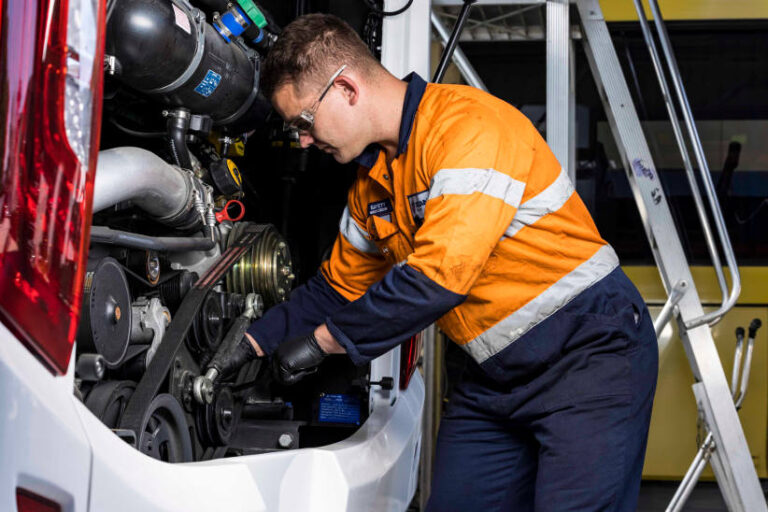Efficient maintenance management is a cornerstone of successful fleet operations, ensuring vehicle reliability, safety, and cost-effectiveness. With advancements in telematics, fleets now have powerful tools to adopt a risk-based approach to maintenance, significantly reducing service costs and downtime. Chris Martin, Senior Manager of Solutions Engineering – APAC at Geotab, spoke to Fleet News Group while at the ATA’s Technology and Maintenance Conference (TMC) to highlight how telematics data like odometer readings, engine hours, and fault codes are transforming maintenance planning for fleets across Australia.
Optimising Maintenance with Real-Time Data
Telematics enables fleet managers to move away from traditional, time-based maintenance schedules, which often involve unnecessary services or unplanned breakdowns. By collecting real-time data, telematics allows fleet managers to monitor vehicle conditions accurately and schedule maintenance based on actual wear and tear.
Martin explains, “Being able to read data from the CAN bus is just one part of that maintenance puzzle. Scheduled maintenance is important, but understanding when you need to do that maintenance—whether a vehicle is due or overdue—can significantly improve efficiency.”
Telematics eliminates manual processes, such as sending staff to physically check vehicle odometers. “I do hear stories of fleets having to send someone around the yard to check odometers when trucks return, to know whether they’re due for an oil change,” Martin says. “If you’ve got 50 trucks coming into a depot, the labour cost alone of catching each truck at the right time can be substantial.”
By using telematics to track odometer and engine hour readings, fleet managers can accurately schedule services when vehicles are off the road, maximising uptime and ensuring vehicles are serviced only when needed.
Predicting Failures Before They Happen
One of the most significant advantages of telematics in maintenance management is the ability to predict failures before they occur. With data collected from the CAN bus, telematics solutions can monitor key indicators, such as engine performance, fluid levels, and cranking voltages. This predictive capability helps fleet managers identify potential issues and take preventive action, reducing the likelihood of unexpected breakdowns.
Martin shares an example of how predictive maintenance has been effective for fleets: “We’ve had success with predictive battery failure technology. For one large delivery fleet, we managed a 20-25% reduction in on-call battery replacements by predicting when batteries were likely to fail.” He elaborates that by analysing cranking voltages across millions of vehicles globally, Geotab can identify patterns that indicate when a battery is nearing failure. “This enables fleets to replace batteries at a convenient time, such as during scheduled service or overnight, rather than during a costly breakdown on the road.”
This predictive approach is not limited to batteries. Telematics can also help monitor the condition of critical engine components like oil, brakes, and tyres. Martin notes, “While some components, like tyres and brakes, are already maintained based on objective measurement, telematics now allows us to get predictive data on components like oil, which has traditionally been maintained based on time or mileage. This kind of insight is a game-changer for fleets looking to adopt a risk-based approach.”
Reducing Costs and Downtime with a Risk-Based Approach
A risk-based approach to maintenance is fundamentally about minimising service costs while maximising vehicle availability. By using real-time telematics data, fleets can better understand how vehicle usage patterns impact component wear. Martin explains, “If a vehicle is used in stop-start traffic or with heavy loads, it may require more frequent maintenance. Conversely, a vehicle used mainly for highway driving may have longer intervals between services.”
This flexibility not only helps reduce unnecessary service costs but also minimises vehicle downtime.
“Condition-based maintenance allows fleets to push out service intervals when vehicles are operating in ideal conditions,” Martin says. “This means that instead of servicing a vehicle every six months, it might be possible to extend that to nine or even 12 months, based on actual usage data.”
Telematics also provides greater visibility into vehicle faults, allowing fleet managers to take corrective action before a breakdown occurs.
“Drivers already have a lot to do, and letting fleet managers know when a check engine light comes on might not always be their priority,” Martin notes.
With telematics, fleet managers can receive immediate alerts about fault codes and assess whether the issue requires immediate attention or can wait until the next scheduled service.
Maximising Fleet Efficiency with Integrated Insights
Telematics integration goes beyond individual vehicle maintenance. By aggregating data across entire fleets, it helps managers identify trends and make informed decisions about broader maintenance strategies.
“With over 75 billion data points being collected daily from over 4.5 million connected vehicles globally, we’re able to identify what a good vehicle start looks like versus a problematic one,” Martin says. This data can be leveraged to improve fleet-wide maintenance schedules, minimise costs, and increase vehicle reliability.
Martin also highlights the environmental benefits of a data-driven maintenance strategy. “Fleets can reduce the use of consumables, such as oil and tyres, by servicing only when necessary, based on actual vehicle conditions,” he explains. This not only cuts costs but also contributes to sustainability goals by reducing waste.
Adopting a risk-based approach to vehicle maintenance is no longer a future aspiration—it’s a reality made possible by telematics. By using data from odometer readings, engine hours, and fault codes, fleet managers can schedule maintenance precisely when needed, predict failures before they happen, and reduce both costs and downtime. As Martin puts it, “Telematics has transformed fleet maintenance from a routine process to a proactive, data-driven strategy that ensures safety, efficiency, and cost savings.






